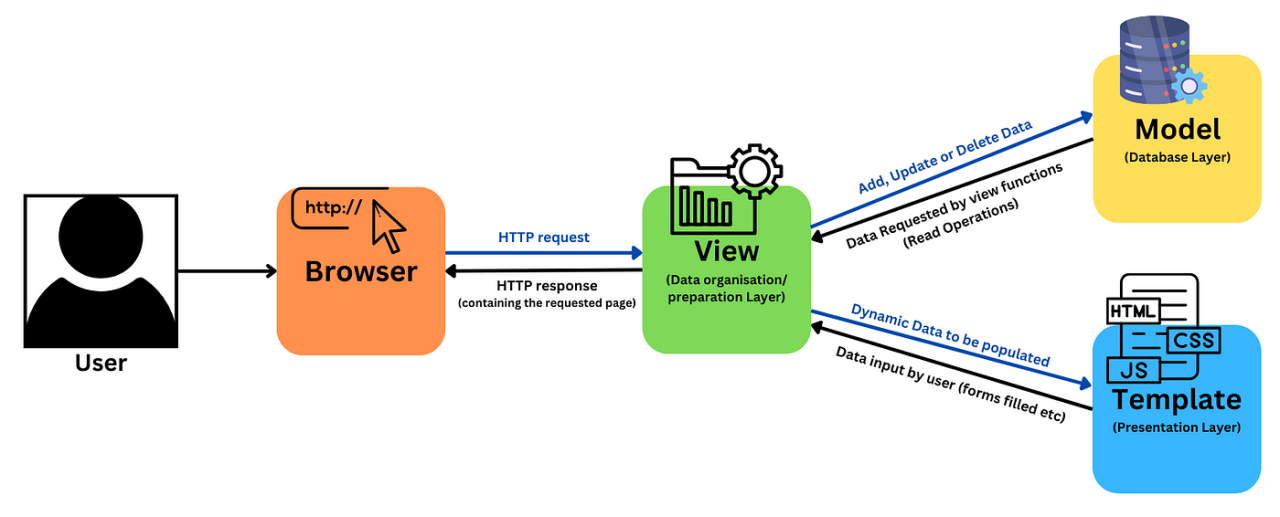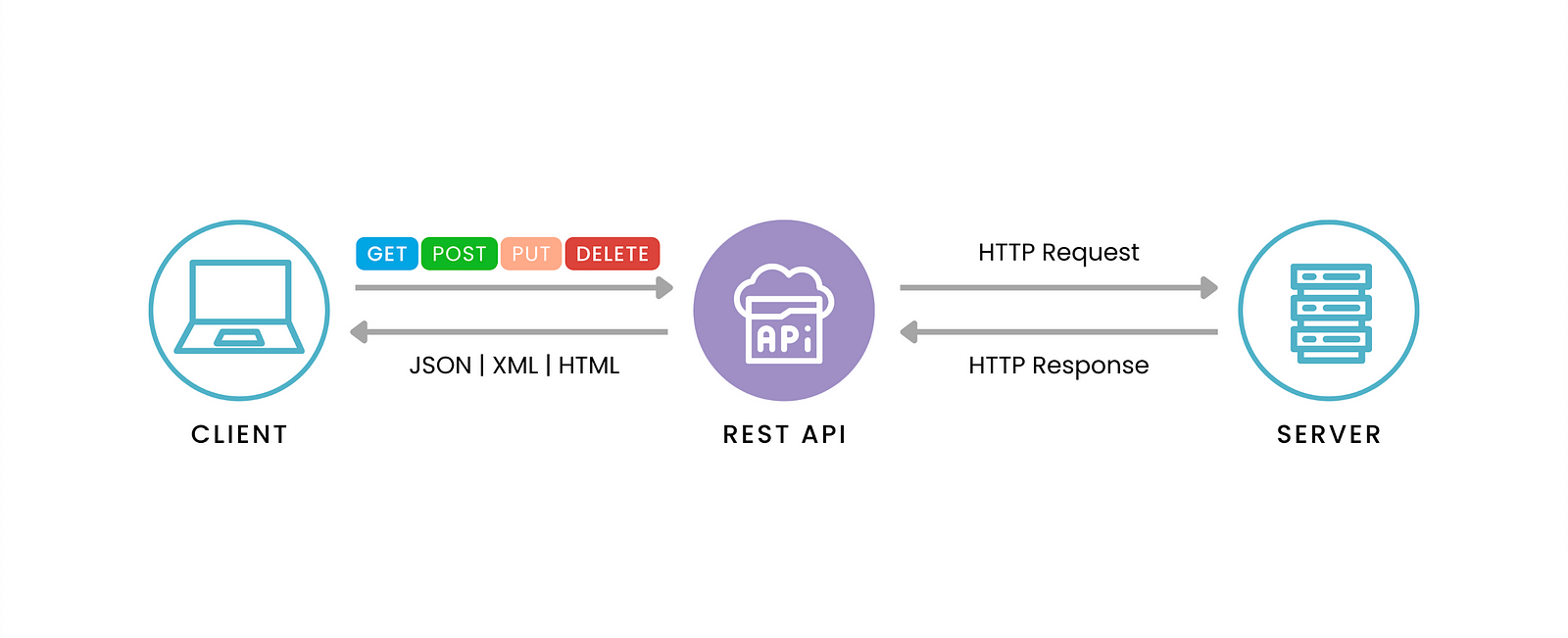IWSD-01 Django Overview
Table of Contents
What is Django?
- Django is a high-level Python web framework used for building robust and scalable web applications quickly. It encourages rapid development and clean, maintainable design.
- Key Features:
- Built-in Tools: Django includes an admin interface, authentication system, URL routing, database management, and more.
- Security: It helps developers avoid common security pitfalls like SQL injection, cross-site scripting, and cross-site request forgery.
- Scalability: Django can handle high-traffic websites and large-scale applications efficiently.
- Use Cases:
- Social media platforms, e-commerce sites, content management systems (CMS), and APIs.
What is a Framework?
- A framework is a collection of pre-written code libraries and tools that provides a foundation to build and deploy applications efficiently.
- Advantages of Frameworks:
- Saves time by providing ready-made modules for common tasks like user authentication, database interactions, and form handling.
- Encourages best practices and standardization in development.
- Examples: Django (Python), Laravel (PHP), Spring (Java), React (JavaScript).
Django Architecture

- Django follows the MVT (Model-View-Template) architecture, ensuring a separation of concerns between business logic, data, and presentation layers.
- Components:
- Model: Represents the database structure. It is used to query, add, or update data in the database.
- Handles the data in the application.
- It communicates with the database and stores or retrieves data.
- Example: Storing user information, products, or blog posts.
- View: Contains the business logic and interacts with the model to fetch data and pass it to the template.
- Manages the logic and processes user requests.
- It fetches data from the Model and passes it to the Template.
- Example: When a user requests a webpage, the View gets the required data and sends it for display.
- Template: Handles the presentation layer by rendering HTML pages based on the data passed from the view.
- Manages the presentation layer.
- Defines how the data will look on the webpage using HTML and CSS.
- Example: Displaying a user profile with their name, photo, and posts.
- Model: Represents the database structure. It is used to query, add, or update data in the database.
Flow of MVT (Model-View-Template)
- User Request: The client (user) sends an HTTP request (GET or POST) to the Django application.
- URL Dispatcher: The request is routed to the appropriate view function based on the URL pattern defined in the urls.py file.
- View: The view function processes the request. It interacts with the model to fetch data or perform logic.
- Template: The data fetched by the view is passed to a template for rendering as an HTML page.
- Response: The template is sent back to the user as a response.
Advantages of MVT Model
- Separation of Concerns: Data, logic, and presentation are handled separately.
- Reusability: Templates and Models can be reused across different parts of the application.
- Scalability: Easy to maintain and extend for larger applications.
Installation in Virtualenv
- Virtualenv creates an isolated Python environment to avoid dependency conflicts between projects.
- Install virtualenv:
pip install virtualenv- Create a virtual environment:
virtualenv env_name- Activate the environment:
env_name\Scripts\activate- Install Django in the virtual environment:
pip install django- Verify Installation:
django-admin --versionCreating a Django Project and Apps
- Project: A Django project is a collection of configurations and applications for a website.
django-admin startproject project_name- App: An app is a module that handles a specific functionality in the project (e.g., blog, user authentication).
python manage.py startapp app_name- Linking the App: Add the app name to the
INSTALLED_APPSlist in the project’ssettings.pyfile. - settings.py: configures the project
- urls.py: maps URLs to views
- manage.py: command-line utility for the project
Creating a Superuser
- What is a Superuser? A superuser is an administrator account that has all permissions, including access to the admin panel.
python manage.py createsuperuser- Enter the following details: Username, Email address, Password and start server to access admin panel
python manage.py runserver- Access the Admin Panel: URL:
http://127.0.0.1:8000/admin/
Other Common Django Commands
- Run the Development Server: Default URL:
http://127.0.0.1:8000/
python manage.py runserver- Create migration files:
- Command:
python manage.py makemigrations - Purpose: Detect changes in the models and create migration files.
- Command:
- Apply migrations:
- Command:
python manage.py migrate - Purpose: Apply the changes to the database.
- Command:
- Check Errors:
python manage.py check
Application Programming Interface
- An API is a set of rules and protocols that allow different software applications to communicate with each other. It acts as an intermediary between two applications, enabling data exchange.
- Why Use APIs?
- To integrate third-party services (e.g., payment gateways, social media).
- To enable data sharing between systems.
- To enhance modular and scalable application development.
- Characteristics of API:
- Communication Bridge: Connects two systems or applications to exchange data.
- Reusability: APIs can be reused across multiple applications and systems.
- Abstraction: Hides complexity of back-end processes & provides a simple interface to users.
- Standardization: Follows standard methods like HTTP, JSON, XML, etc., to make integration easier.
- Examples of APIs:
- Weather API to fetch real-time weather data.
- Payment APIs like PayPal or Stripe for online transactions.
Types of APIs
- Open APIs (Public APIs):
- Available for public use.
- Example: Twitter API for social media integration.
- Internal APIs (Private APIs):
- Used within an organization to integrate internal systems.
- Example: APIs for a company’s HR software.
- Partner APIs:
- Shared with specific business partners under controlled access.
- Example: APIs shared between payment providers and e-commerce platforms.
- Composite APIs:
- Combine multiple API calls into a single request.
- Example: A booking service API that retrieves flight and hotel details simultaneously.
Representational State Transfer API

- REST (Representational State Transfer) is a lightweight architecture that defines a set of constraints for creating APIs.
- Key Features:
- Stateless: Each request contains all the necessary information, with no dependency on previous requests.
- Client-Server Separation: The client and server operate independently.
- Cacheable: Responses can be cached to improve performance.
- Common HTTP Methods in REST APIs:
- GET: Retrieve data (e.g., fetch a user’s profile).
- POST: Create new data (e.g., add a new record).
- PUT: Update existing data (e.g., modify user details).
- DELETE: Remove data (e.g., delete a user account).
RESTful Architecture
- Principles:
- Uniform Interface: Use standard conventions for resources (e.g., /users for accessing user data).
- Stateless: Each request must contain all the information needed.
- Cacheable: Responses should define whether they can be cached.
- Layered System: The client should not know the server’s infrastructure.
- Resource Based: Everything is treated as a resource, identified b URLs.
- Client-Server Model: The client (frontend) and server (backend) are separate, allowing scalability.
- Resource Representation:
- Resources (data) are represented as JSON or XML in REST APIs.
Request Library
- A Python library used to send HTTP/HTTPS requests to interact with APIs.
- It simplifies the process of working with APIs, handling URL parameters, headers, authentication, and file uploads while providing support for secure connections with SSL.
- Features:
- Supports GET, POST, PUT, DELETE, and other HTTP methods.
- Handles headers, parameters, authentication, and more.
import requests
response = requests.get("https://api.example.com/users")
print(response.json())Assert Statements
- A debugging tool used to test assumptions in the code. If the condition is false, an
AssertionErroris raised. - If the condition evaluates to
True, the program continues execution. If it evaluates toFalse, anAssertionErroris raised, optionally with a custom error message. - It is commonly used in testing to validate assumptions and ensure that the code behaves as expected.
- Syntax:
assert condition, "Optional error message"
x = 10
assert x > 5, "x should be greater than 5"Testing
- Testing verifies that a software application meets the specified requirements and is free from defects
- Types of Testing in the Context of APIs:
- Unit Testing: Testing individual components like functions or endpoints.
- Integration Testing: Ensuring different API endpoints work together.
- Functional testing: Validates the application against user requirements by simulating user behavior.
- Security Testing: Ensuring the API is protected from vulnerabilities.
- Example: Using Python’s
unittestorpytestframeworks for automated API testing.
GIT (Global Information Tracker)
- A version control system used to track changes in source code during development.
- Key Concepts:
- Repository (Repo): A directory containing project files and a history of changes.
- Commit: Saving changes to the repository.
- Branch: A parallel version of the code.
- Common Git Commands:
git init: Initialize a repository.git add: Stage changes for commit.git commit: Save changes.git push: Upload changes to a remote repository.
SQL (Structured Query Language)
- SQL is used to interact with relational databases to store, retrieve, and manipulate data.
- Key Features:
- Database Interaction: SQL is used to query and modify data stored in relational databases like MySQL, PostgreSQL, SQL Server, Oracle, and SQLite.
- Declarative Language: SQL focuses on what to do (e.g., retrieve data) rather than how to do it.
- Portability: SQL can be used across different database management systems with slight syntax variations.
- Multi-user Accessibility: Multiple users can interact with a database concurrently.
- Security: SQL provides mechanisms to control data access and enforce data security through user roles and permissions.
- Examples of SQL Databases: MySQL, PostgreSQL, SQLite, Oracle.
- Data storage in tables (rows and columns).
- Support for complex queries.
- Scalability for handling large datasets.
CRUD Operations in SQL
- CRUD stands for Create, Read, Update, Delete, the four basic operations for managing data in a database.
- Explanation with SQL Queries:
- Create: Insert new data.
INSERT INTO users (id, name) VALUES (1, 'John Doe');- Read: Retrieve data.
SELECT * FROM users;- Update: Modify existing data.
UPDATE users SET name = 'Alice Wilson' WHERE id = 1;- Delete: Remove data.
DELETE FROM users WHERE id = 1;